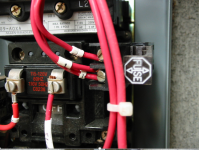jms53
Member
- Location
- Clinton, In
What are the NEC requirements for control wiring protection that does not leave the enclosure? Have 2 relays being controlled by individual switches found on panel door. Overcurrent and ground fault protection (20 Amp Breaker) for two motors are provided by breakers and internal motor thermals. Using #14 AWG to control definite purpose relays found in enclosure. Motors are fed with #12 AWG. Comments?
Thanks,
Thanks,



